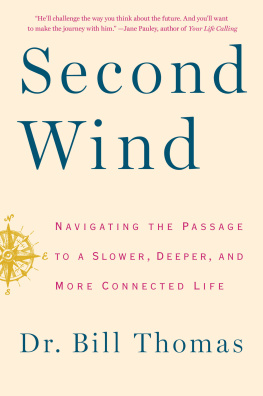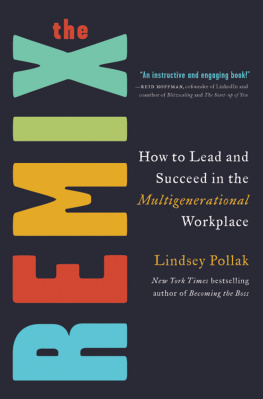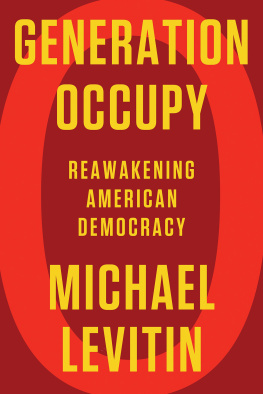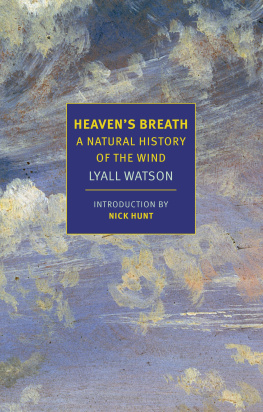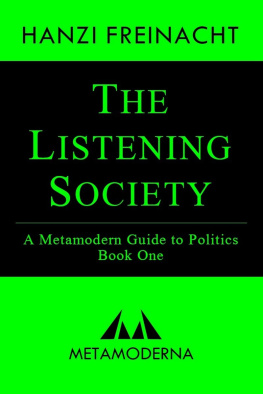ALSO BY DR. BILL THOMAS
Tribes of Eden
In the Arms of Elders
What Are Old People For?
The Eden Alternative Handbook
Learning from Hannah
Open Hearts Open Minds
Life Worth Living
The Eden Alternative


Simon & Schuster
1230 Avenue of the Americas
New York, NY 10020
www.SimonandSchuster.com
Copyright 2014 by Dr. Bill Thomas
All rights reserved, including the right to reproduce this book or portions thereof in any form whatsoever. For information address Simon & Schuster Subsidiary Rights Department, 1230 Avenue of the Americas, New York, NY 10020.
First Simon & Schuster hardcover edition March 2014
SIMON & SCHUSTER and colophon are registered trademarks of
Simon & Schuster, Inc.
For information about special discounts for bulk purchases,
please contact Simon & Schuster Special Sales at 1-866-506-1949
or business@simonandschuster.com.
The Simon & Schuster Speakers Bureau can bring authors to your live event. For more information or to book an event contact the Simon & Schuster Speakers Bureau at 1-866-248-3049 or visit our website at www.simonspeakers.com.
Designed by Ruth Lee-Mui
Library of Congress Cataloging-in-Publication Data
Thomas, William H., 1959
Second wind : navigating the passage to a slower, deeper, and more connected life /
Dr. Bill Thomas. First Simon & Schuster hardcover edition.
pages cm
Includes bibliographical references.
1. Baby boom generationSocial aspectsUnited States.
2. Older peopleUnited StatesSocial conditions. 3. Longevity
United StatesSocial aspects. 4. Conduct of life. I. Title.
HN58.T46 2014
305.26dc23 2013035558
ISBN 978-1-4516-6756-1 (ebook)
ISBN 978-1-4516-6758-5 (ebook)
For Kavan
Contents
13 Enthusiasm
Preface
I spent the first half of my working life serving as a physician, a geriatrician a specialist in the care of the old. Close observation and professional training have schooled me in the many and varied difficulties that can accompany entry into old age. My practice also revealed how heavily our societys blatant and unapologetic ageism weighs upon young and old alike. It is customary in our time for people to console themselves with the belief that age is simply a state of mind. When they close their eyes, millions of people can still hear Joni Mitchell singing,We are stardust. We are golden.
Years spent in the company of very old people offered me a unique perspective from which to view the difficulties that accompany youth. The elders I cared for generously shared their most poignant memories with me, and their lived experience helped me grasp a handful of truths about my life and the world in which I live. The stories elders told me also led me to ask questions about the future of my generation. What stories would we be eager to tell as we looked back at the history through which we lived? How might time and experience change our values and our priorities? What do we still have to learn about the things that matter most?
A half century or more now trails behind those born in the aftermath of the Second World War. Though many still deny the fact, youth slipped from their grasp a long time ago. The mirror, however, remains a teller of truth. The complicated mixture of feelings we experience when we study our own reflections is both very personal and shared by millions of our peers. These emotions are, in fact, connected to some of the most unsettling and dangerous features of contemporary culture. Out of sight, and almost always out of mind, aging is remaking us and our society. With the same gentle power that allows water to carve stone, time is having its way with those who would be forever young.
Those born after World War II are changing in important ways, but the mythology they created about themselves remains suspended in time. As the gap between this generation and its youthful self-image picture of itself grows, so does the feeling that life is, somehow, out of balance. This conflict between mythology and reality would be incidental to current events but for the fact that the postwar generation was endowed, by history and demography, with the power to transform personal troubles into pressing public issues. The struggles of the 1960s and 1970s, which are supposed to have arisen from a generations fervent embrace of rebellion, were actually the product of a divisive and highly volatile conflict over the structure, function, and meaning of adulthood and maturity.
The story of the postwar generations first coming of age is exceedingly well worn. For decades people have been accustomed to hearing this story being told from rooftops, televisions, and radios. Accordingly, there is a pervasive sense that nothing new can be wrung from so familiar a tale. During the years I spent caring for elders, I came to understand that the more often a story is repeated, the more likely it is that the teller is using it to conceal rather than to reveal.
My natural disposition and professional experience have caused me to be interested in the reinterpretation of the postwar generations era. Because I was born in 1959 and was therefore a child during the sixties rather than a child of the sixties, I have always trailed behind the vast bulk of the postwar generation. Ive been close to its cultural center of gravity without actually being part of its many dramas. In the conventional telling, this is a mythology that continues to celebrate a long vanished youth. I have done my best to reinterpret and extend this story because I am fascinated by the questions surrounding who these people may yet become.
Some will ask why a physician should be so concerned with history. In fact, the art of medicine is primarily a history-taking profession. The skillful physician takes care to ask probing questions about what preceded the so-called present illness. Details of the patients medical history are supplemented with an occupational history; a family history; and, when necessary, a travel history. The following pages explore the developmental challenges that lie ahead of the postwar generation and in doing so cannot help but ask How did we arrive at this moment? This generations emergence out of childhood comprises a colorful and eventful period in our shared history. It also carries important clues about the cultural forces that will shape the postwar generations fitful journey into a new life phase, a life beyond adulthood.
During the course of my career I have listened to hundreds if not thousands of life stories. People have tearfully confessed to me youthful sins and foibles that now lie seventy years past. I did my best to receive these stories with tenderness and compassion. The life story of an elder rightly understood offers us the distilled essence of life as one human being has lived it. All of the great story listeners in history have understood that opening ones mind can change a familiar tale into something new, something that can change how we see the world.
While I freely admit to its faults, biases, omissions, and errors, this book is my attempt to retell the foundational generational tale of our time. In writing this book I have done my best to unmask the lazy generational self-justifications that have been allowed to pass as conventional wisdom. I have attempted to retell the postwar generations now tattered story and complete it with an exciting, though yet to be realized, developmental journey that can lead the postwar generation into the uncharted terrain of life beyond adulthood. We are approaching a second great coming of age that will change how members of the postwar generation see themselves and the world in which they live. This is where they will form the legacy they will leave for those who follow in their wake.
Next page
